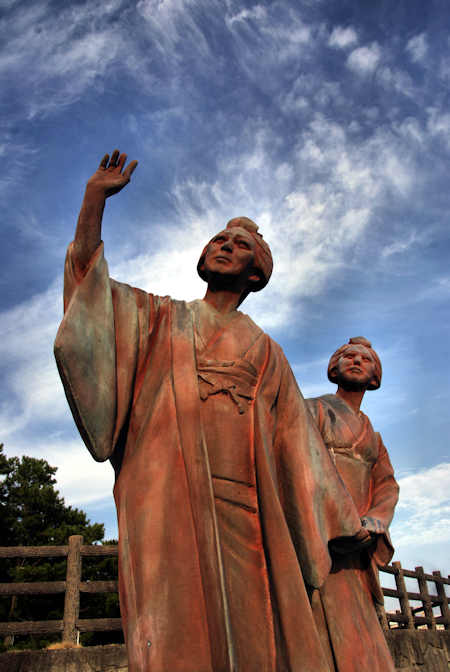Showing posts with label dosojin. Show all posts
Showing posts with label dosojin. Show all posts
Monday, October 17, 2022
Nomachi Takano Shrine
Wednesday, January 19, 2022
Day 14 on the Ohenro Trail Winds Down
Ohenro Trail Day 14
Saturday, September 18, 2021
Koinoki Shrine the Love Shrine in Fukuoka
Koinoki Shrine
I can find no information about the kami Koinoki no mikoto. I strongly suspect that it was simply the name for a local kami and because of the idiosyncrasies of the Japanese language the Chinese character representing"koi" was changed to the one that reads as "love". This kind of redefining of words is fairly common, perhaps the most well-known example being "Karate". Originally kara was written using the character meaning China, but this was rewritten by the Meiji government to the character for "empty hand", thereby obscuring the Chinese origin of the martial art.
This was my final stop on my 50th day walking the Kyushu Pilgrimage that had started out in the fog further south in Arao, Kumamoto. On my way north I stopped in at shrines before reaching one of the pilgrimage temples. I had a wonderful time exploring the nearby Kyushu Geibunkan and its' annexes before reaching Mizuta Tenmangu.
Thursday, December 19, 2013
Hachizu Shrine
After leaving Usa Hachimangu and heading towards the Kunisaki Peninsula I chose to avoid the main road and instead headed through the back roads through the village of Hachizu where I stopped in at Hachizu Shrine.
There is a very unusual mix of kami enshrined here, the primary being Amenominakanushi, by some accounts the first kami to come into being, yet very little is known or written about him. There were apparently no ancient shrines deicated to him, but in the Meiji era when the buddhas and kami were seperated, many shrines chose to rename Myoken, the deity of the North Star, Amenominakanushi....
The next is Yaekotoshironushi, another version of the name Kotoshironushi, the son of Okuninushi and now more commonly equated with Ebisu. Then there is the pair of kami Mikahayahi and Hihahayahi who who created out of blood dripping from the sword that Izanagi used to kill the god of fire. Finally there is Uganomitama, the female aspect of Inari.
I am guessing that the pile of rice straw is to make new shimenawa. Secondary shrines within the grounds include Kibune, Tenjin, Konpira, Gion, Inari, Dosojin, and Wakamiya.
Labels:
amenominakanushi,
dosojin,
gion,
hihahayahi,
inari,
kibune,
konpira,
kotoshironushi,
kunisaki fall,
kyushu,
mikahayahi,
oita,
Shrine,
tenjin,
uganomitama,
wakamiya
Monday, June 20, 2011
Izumoji Sainokami Shrine
The shrine is tucked away a little to the west of Shimogamo Shrine, though it was originally located on the bank of the Kamo River nearby.
The name refers to the old "road" to Izumo, and sainokami is a later name of dosojin, the phallic stones at roadsides and crossroads that were the site of spirit-pacification rites. Plagues travelled along the roads and were experienced as demons, so these sites were to protect from such demons.
The dosojin became associated with Sarutahiko, and he is the main kami enshrined here. Also enshrined is Uzume, his wife, Ninigi, who Sarutahiko guided down to earth, Okuninushi and Kotoshironushi, the Izumo kami, and several others.
Sarutahiko took on the visage of a monkey, hence the image on the numerous ema.
It is said that in olden days women who wanted a divorce would come here to pray.
Labels:
dosojin,
kotoshironushi,
Kyoto,
ninigi,
okuninushi,
sainokami,
sarutahiko,
Shrine,
uzume
Monday, March 14, 2011
Funadama Inari Shrine
The shrine is located in a residential area not far north of the main train station in Matsue, and while it is an Inari shrine there are none of the usual trappings associated with Inari.
In the corner was a Jizo, and I always somehow find it reassuring that the governments attempt to seperate the Buddhas and the Kami was never completely successful.
The main kami is of course Ukanomitama, and the secondary kami are Sokotsutsuno o no mikoto, Nakatsutsuno o no mikoto, and Uwatsutsuno o no mikoto, the triad of kami known mostly as the Sumiyoshi Kami. With strong connections to water and sea travel, the Sumiyoshi Kami are now mostly associated with the Sumiyoshi Taisha in Osaka, though originally they were from north Kyushu and have strong connections with Korea.
By the side of the shrine was a nicely shaped phallic stone. There was no signboard for it, but as Sarutahiko is listed as enshrined at the shrine the stone may well be a Dosojin.
There were a couple of smaller secondary shrines within the grounds that most likely were gathered here from the surrounding area. Enshrining Okuninushi, Susano, and Amaterasu, there is also a Haniyama Hime listed who is an earth/clay kami created from the feces of Izanami. The final kami listed here is Kan Yamato Iware Hiko no Mikoto which is the long name for Jinmu, the mythical first emperor of Japn
Labels:
Amaterasu,
dosojin,
haniyama hime,
inari,
Izumo,
matsue,
nakatsutsuno,
okuninushi,
phallus,
sarutahiko,
Shrine,
sokotsutsuno,
Susano,
uwatsutsuno
Monday, December 13, 2010
The phallic stones of Asuka Nimasu Shrine
There is a collection of phallic stones at the Asuka Nimasu Shrine that I would guess have been collected from the surrounding area.
A few of them are paired with a "female" stone.
I think there is a good chance that these, or some of them at least, are Dosojin.
Dosojin, sometimes called Sainokami, were phallic stones placed at the roadside at community borders.
Often referred to as protective deities of travellers, their original use seems to be protecting the village from evil/pollution rather than protecting travellers.
Later the dosojin became rocks carved with a male-female couple, and later still Jizo statues took over some of their functions.
In some places Sarutahiko is associated with Dosojin.
Labels:
asuka,
dosojin,
Imamiya shrine,
nara,
phallic,
sainokami,
sarutahiko
Subscribe to:
Posts (Atom)
































